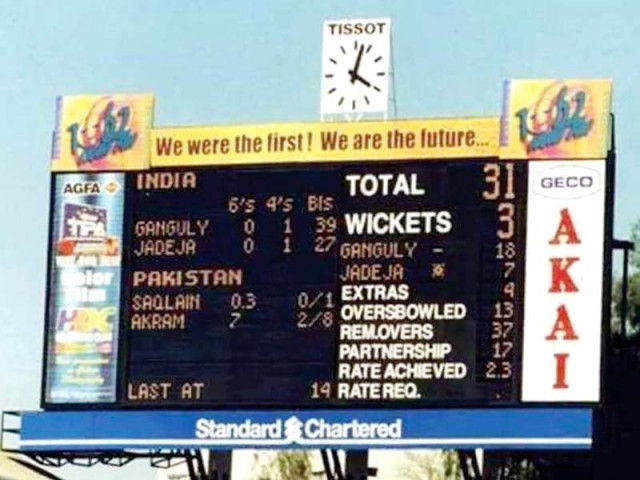Keeping time: Cricket’s behind the scenes round-the-clock job
Pakistan’s only official match clock, serving the nation for more than 30 years

Iqbal and Bilal have both been travelling around the country with the clock; the father doing so since 1984 and the son since 2009. PHOTOS COURTESY: BILAL ASIF
In Pakistan, a single clock has been doing that job for more than 30 years; travelling the country and running around in the cricketing circuit wherever it is needed.
The clock has been around since 1984, experiencing its first taste of international cricket in October, 1985 when the side hosted Sri Lanka in a Test in Faisalabad. It toured the nation with the national team until cricket left the country — reduced now to just domestic matches.
The decision of putting up a clock was taken after the International Cricket Council ruled that every cricket stadium should have an official clock.
When no matches are being played, Asif Iqbal keeps it for maintenances and safe-keeping.
“It will cost the Pakistan Cricket Board (PCB) more to have a permanent clock in each stadium as these clocks are quite expensive to maintain,” said Iqbal. “That is where I come in and I travel the country with the clock.”

The clock — larger than its keeper at six feet high and four feet wide — is built so as to be easily removable. “The clock is foldable so that it can be moved easily and without getting damaged,” explained Iqbal, revealing that the dial is four feet high and two feet are left blank for the logos of sponsors. “The clock is used in matches that are either being broadcasted or where important teams play, especially if it is an international match.”
Once it was Wills Cigarette that sponsored the clock, but then cigarette adverts were banned in 2000 and sponsors became much more difficult to find; meaning that the PCB had to burden the cost.
The times of his life
Iqbal’s busiest days understandably came when Pakistan co-hosted the 1996 World Cup, when he had to shift the clock after every match — it is a time that Iqbal looks back upon with particular fondness.
“We had to spend the night before the match at the clock tower as the spectators would start to gather from five in the morning and it used to be difficult for us to get inside in the morning,” he said.
Iqbal recalls the brushes he had with Pakistan’s cricketing legends over the years and feels they were the highlights of a career that lasted more than two decades. “I have seen the biggest names of Pakistan cricket — Imran Khan, Wasim Akram, Waqar Younis, Inzamamul Haq, you name it — and it has been such an honour.”
Passing on the baton
After serving Pakistan cricket for 24 years, Iqbal passed on the responsibility to his son Bilal Asif in 2008. Now it is the 26-year old who puts up the clock during matches. “I have to repair other clock towers around Pakistan so I gave the cricket clock to Bilal,” said Iqbal.
Bilal has seen precious little of international cricket during his time and was preparing for the third day of the Sri Lanka-Pakistan Test match when that fateful terrorist attack took place. “I was at the stadium preparing for the day when I was told about the incident,” he said. “Since then, there have only been domestic matches but companies are still willing to sponsor the clock. During the Pentangular Cup that took place before the World Cup, I had to double the width of the clock from four feet to eight feet to make it more visible and allow for more sponsors on it.”
Change in technology
“During the second Test between Sri Lanka and Pakistan at the Jinnah Stadium in Sialkot in October, 1985, the power went out but the clock had to be kept running so I had to push it manually after each minute,” recalled Iqbal. “Then there were several other matches where the clock stopped due to load-shedding. Due to this we had to convert it to use solar energy but did not have the required resources.”
However, the long wait was over four years ago. “We were finally able to install solar technology into the clock in 2011 and changed some of its mechanism so it would consume less power,” added Iqbal. “However, the clock’s dial and most of its internal parts remain the same.”
A new plan is in place
Now Bilal is working on a project for the PCB to install permanent solar-powered clocks in three stadiums — The National Stadium of Karachi, Gaddafi Stadium and Rawalpindi Cricket Stadium — which will just need to be checked before matches. “I have submitted a proposal to the PCB with the help of my father and now wait for their reply,” told Bilal.
Time stops for no one
Iqbal and Bilal, perhaps more than anyone else, know how much the times have changed since the clock’s first public appearance. Cricket fights for its survival in Pakistan, Bilal and Iqbal wait patiently for the return of the sport to the country — and in the meanwhile, the clock keeps on ticking.
Published in The Express Tribune, April 22nd, 2015.
Like Sports on Facebook, follow @ETribuneSports on Twitter to stay informed and join in the conversation.



















COMMENTS
Comments are moderated and generally will be posted if they are on-topic and not abusive.
For more information, please see our Comments FAQ